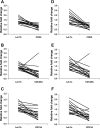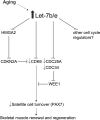Aging and microRNA expression in human skeletal muscle: a microarray and bioinformatics analysis
- PMID: 20876843
- PMCID: PMC3110890
- DOI: 10.1152/physiolgenomics.00148.2010
Aging and microRNA expression in human skeletal muscle: a microarray and bioinformatics analysis
Abstract
A common characteristic of aging is loss of skeletal muscle (sarcopenia), which can lead to falls and fractures. MicroRNAs (miRNAs) are novel posttranscriptional modulators of gene expression with potential roles as regulators of skeletal muscle mass and function. The purpose of this study was to profile miRNA expression patterns in aging human skeletal muscle with a miRNA array followed by in-depth functional and network analysis. Muscle biopsy samples from 36 men [young: 31 ± 2 (n = 19); older: 73 ± 3 (n = 17)] were 1) analyzed for expression of miRNAs with a miRNA array, 2) validated with TaqMan quantitative real-time PCR assays, and 3) identified (and later validated) for potential gene targets with the bioinformatics knowledge base software Ingenuity Pathways Analysis. Eighteen miRNAs were differentially expressed in older humans (P < 0.05 and >500 expression level). Let-7 family members Let-7b and Let-7e were significantly elevated and further validated in older subjects (P < 0.05). Functional and network analysis from Ingenuity determined that gene targets of the Let-7s were associated with molecular networks involved in cell cycle control such as cellular proliferation and differentiation. We confirmed with real-time PCR that mRNA expression of cell cycle regulators CDK6, CDC25A, and CDC34 were downregulated in older compared with young subjects (P < 0.05). In addition, PAX7 mRNA expression was lower in older subjects (P < 0.05). These data suggest that aging is characterized by a higher expression of Let-7 family members that may downregulate genes related to cellular proliferation. We propose that higher Let-7 expression may be an indicator of impaired cell cycle function possibly contributing to reduced muscle cell renewal and regeneration in older human muscle.
Figures






Similar articles
-
Aging differentially affects human skeletal muscle microRNA expression at rest and after an anabolic stimulus of resistance exercise and essential amino acids.Am J Physiol Endocrinol Metab. 2008 Dec;295(6):E1333-40. doi: 10.1152/ajpendo.90562.2008. Epub 2008 Sep 30. Am J Physiol Endocrinol Metab. 2008. PMID: 18827171 Free PMC article. Clinical Trial.
-
Diminished skeletal muscle microRNA expression with aging is associated with attenuated muscle plasticity and inhibition of IGF-1 signaling.FASEB J. 2014 Sep;28(9):4133-47. doi: 10.1096/fj.14-254490. Epub 2014 Jun 13. FASEB J. 2014. PMID: 24928197 Free PMC article.
-
Differential expression patterns of growth-related microRNAs in the skeletal muscle of Nile tilapia (Oreochromis niloticus).J Anim Sci. 2012 Dec;90(12):4266-79. doi: 10.2527/jas.2012-5142. Epub 2012 Jun 28. J Anim Sci. 2012. PMID: 22745188
-
Role of microRNAs in the age-related changes in skeletal muscle and diet or exercise interventions to promote healthy aging in humans.Ageing Res Rev. 2014 Sep;17:25-33. doi: 10.1016/j.arr.2014.05.001. Epub 2014 May 14. Ageing Res Rev. 2014. PMID: 24833328 Review.
-
Embryonic stem cell microRNAs: defining factors in induced pluripotent (iPS) and cancer (CSC) stem cells?Curr Stem Cell Res Ther. 2009 Sep;4(3):168-77. doi: 10.2174/157488809789057400. Curr Stem Cell Res Ther. 2009. PMID: 19492978 Review.
Cited by
-
MicroRNAs in skeletal muscle biology and exercise adaptation.Free Radic Biol Med. 2013 Sep;64:95-105. doi: 10.1016/j.freeradbiomed.2013.07.004. Epub 2013 Jul 18. Free Radic Biol Med. 2013. PMID: 23872025 Free PMC article. Review.
-
Plasma microRNA signature associated with skeletal muscle wasting in post-menopausal osteoporotic women.J Cachexia Sarcopenia Muscle. 2024 Apr;15(2):690-701. doi: 10.1002/jcsm.13421. Epub 2024 Jan 25. J Cachexia Sarcopenia Muscle. 2024. PMID: 38272849 Free PMC article.
-
Lysine-specific demethylase 2B (KDM2B)-let-7-enhancer of zester homolog 2 (EZH2) pathway regulates cell cycle progression and senescence in primary cells.J Biol Chem. 2011 Sep 23;286(38):33061-9. doi: 10.1074/jbc.M111.257667. Epub 2011 Jul 11. J Biol Chem. 2011. PMID: 21757686 Free PMC article.
-
Microfluidic generated EGF-gradients induce chemokinesis of transplantable retinal progenitor cells via the JAK/STAT and PI3kinase signaling pathways.PLoS One. 2013 Dec 23;8(12):e83906. doi: 10.1371/journal.pone.0083906. eCollection 2013. PLoS One. 2013. PMID: 24376770 Free PMC article.
-
Muscle specific miRNAs are induced by testosterone and independently upregulated by age.Front Physiol. 2014 Jan 23;4:394. doi: 10.3389/fphys.2013.00394. eCollection 2013. Front Physiol. 2014. PMID: 24478708 Free PMC article.
References
-
- Bigot A, Jacquemin V, Debacq-Chainiaux F, Butler-Browne GS, Toussaint O, Furling D, Mouly V. Replicative aging down-regulates the myogenic regulatory factors in human myoblasts. Biol Cell 100: 189–199, 2008 - PubMed
-
- Boehm M, Slack F. A developmental timing microRNA and its target regulate life span in C. elegans. Science 310: 1954–1957, 2005 - PubMed
-
- Bussing I, Slack FJ, Grosshans H. let-7 microRNAs in development, stem cells and cancer. Trends Mol Med 14: 400–409, 2008 - PubMed
-
- Calder AG, Anderson SE, Grant I, McNurlan MA, Garlick PJ. The determination of low d5-phenylalanine enrichment (0.002–0.09 atom percent excess), after conversion to phenylethylamine, in relation to protein turnover studies by gas chromatography/electron ionization mass spectrometry. Rapid Commun Mass Spectrom 6: 421–424, 1992 - PubMed
Publication types
MeSH terms
Substances
Grants and funding
LinkOut - more resources
Full Text Sources
Other Literature Sources
Medical
Molecular Biology Databases
Research Materials

